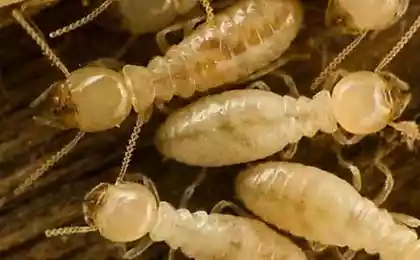760
Animal diseases dangerous to humans
There are infectious and parasitic diseases common to man and animals man becomes infected by them in contact with sick animals, and as a result of eating the meat of sick animals, contaminated water and through blood-sucking insects and mites.

Anthrax - an acute febrile disease of domestic, wild animals and people. Called aerobic Bacillus, which in the animal body forms a capsule, and outside of it — controversy. The pathogen may spread by water contaminated by infected sewage of the tanneries, sistemic and other enterprises processing animal raw materials and animal feed. Infection of humans occurs when removing and skin treatment, via bloodsuckers, etc. People often become ill skin form. Infected through the cracks, scrapes and other wounds of the skin of hands, face and other open body parts. In this form, the site of introduction of the Bacillus forms a bluish-red nodule, turning then to a dark red vial containing a reddish liquid. After a while the bubble bursts, the tissue where he was, mortify, and next is having the same knots and bubbles. This whole process is accompanied by a high fever.
The rigor of the common veterinary-sanitary measures in the land and personal hygiene — reliable protection against anthrax.
Rabies - an acute infectious disease. When the animal bites be sure to visit a dentist for special events on vaccination against rabies. In case of failure of treatment the lethal outcome occurs in one hundred cases out of a hundred. Dogs, long time living in the cottages, and dogs of hunting breeds should be mandatory to vaccinate against rabies. An acute infectious disease. Called invisible under ordinary microscope filterable neurotropic virus transmitted from a sick animal to a healthy saliva from bites. Ill people, domestic animals, including poultry. The latent period of the disease — from 10 days to 1 year. Its duration depends on the distance of the bite from the Central nervous system and the nature of the wounds.
A characteristic symptom of rabies in animals - fearfulness or pronounced irritability of the animal, reaching to the rampage. Sick dogs, cats and other animals without sufficient grounds to catch people and animals, biting, eating inedible objects, tearing his skin, eager to escape. In dogs appears hoarse barking, convulsions, difficulty swallowing, alternating complete paralysis of the swallowing and chewing muscles, wobbly gait, hind limb paralysis, fear of water. Death occurs within 4-6 days. At the quiet form of rabies animals can not swallow food. Develops General paralysis, leading to death.
Measures for control of rabies:
the sick and suspected animal disease to be isolated or destroyed;
— the bodies keep out of reach of animals (especially rodents) in place before the arrival of the supplies, but not more than 2 days, and then buried in the cattle cemetery to a depth of not less than 2 m;
— to disinfect the infected places 2-percent solution of formalin or caustic soda, or boiling water; clothes soiled with saliva of a sick animal, washed, boiled and ironed with a hot iron;
— all bitten people to send to the nearest sanitary-epidemiological station or health facility for vaccination against rabies.
Brucellosis is disease of domestic and wild animals: wolves, foxes, rabbits; birds: sparrows, pigeons, pheasants, etc. People often become infected by eating meat of an infected animal. You should observe the rules of hygiene. In case of illness contact a doctor. Brucellosis is a chronic disease, the causative agent of brucellosis is a small, still visible under the microscope wand. It remains viable for a long time. Symptoms: fever up to 40 degrees fever, which in some cases comes back.
Observance of rules of personal hygiene at autopsy and butchering of animals and prevents contamination.
Tularemia is an infectious disease. Most common in rodents, fur-bearing animals. Causes the disease aerobic, visible under the light microscope, the stationary bacteria. Infection occurs contact, through the digestive or respiratory tract, and in the warm time of the year — via blood-sucking insects. The hunters are infected when visiting a dysfunctional ponds, swamps and meadows; at night in your hay, straw; while butchering sick animals produced. The pathogen can penetrate into the human body while bathing in the pond, even through the intact skin and mucous membranes of the eyes. The latent period of the disease is short.
Prevention — hygiene. The disease prevented the extermination of rodents and parasitic arthropods, vaccination hunters and other people visiting a troubled land, drinking only boiled water, protection of water wells against ingress of rodents, disinfection of skins and carcasses.
Access to a doctor in case of infection is necessary.
Ornithosis or psittacosis - an infectious disease of domestic, wild birds and humans birds sick chickens, pheasants, ducks, pigeons, seagulls, parrots, etc. is Called filter virus. Virus diseases are killed in 15 minutes at a temperature of 65-70 degrees, the ice stored up to 2 months resistant to drying. Killed in 3% strength solution of chlorine bleach in 3 hours. The disease often has a latent period, and so healthy looking birds can be a source of dispersion of the pathogen of this disease in nature. Birds become infected by contact of the healthy with the sick, through contaminated food and air, which contains small particles of infected faeces, urine, feathers, nasal discharge etc. Disease in humans is possible with post-slaughter processing of the birds is the plucking of feathers and cut-up carcasses, begins with chills and weakness, accompanied by headache and pain in the joints. In the case of a disease hospitalization in infectious diseases hospital.
Toxoplasmosis - a disease of wild and domestic animals and is transmitted to man. The disease causes massive death of animals. Identified and eliminated with the help of medical and veterinary services. Acquired a large n epizootic and epidemiological importance, since it is established that in mammals, birds and humans one common causative agent is visible under the microscope are simple parasitic — Toxoplasma gondii. Toxoplasmosis refers to a group of diseases with natural foci. A person can be infected both from humans and from animals.
From naturally infected animals affects the Central nervous system, peripheral nerves. The disease usually occurs in the form of animal disease outbreaks with significant mortality, mainly of calves. In dogs, there is a depression of General condition, emaciation, weakness, discharge from eyes and nose, pallor of visible mucous membranes, coughing, vomiting, shortness of breath, fever and a disorder of the Central nervous system. Carriage of Toxoplasma among people is widespread. From clinically healthy carriers can be born sick with toxoplasmosis children. In some cases, Toxoplasma can cause severe disease in adults.
Transmission of the pathogen from one organism to another occurs in different ways: in utero, through contact with patients or the environment via the digestive and respiratory tracts, sexually transmitted. Be infectious sputum, saliva, vomit, urine, feces, milk, meat. Mechanical transfer of Toxoplasma by arthropods. Flies, for example, after 2 h can burp captured their infective material which does not lose infectivity, and in the body of the bug is contagious is not lost up to 5 h. carriers of the pathogen of toxoplasmosis are some mites. Clinical manifestations of toxoplasmosis in humans are extremely varied.
Toxoplasmosis - it is necessary to identify and eliminate with the help of medical and veterinary authorities. You should not feed raw to dogs, cats internal organs of hunted animals, the head and other offal, as they can be a source of infection.
Ringworm - a fungal infection of the skin. Human infection occurs usually from dogs and cats, often home. Mandatory attendance to a veterinary facility for Pets and access to a doctor for a person.
Ringworm in dogs cause two types of fungus: Trichophyton and microsporon. Affected skin of the head, neck, and extremities. Usually on the scalp and cheeks are formed narrow, thick, painful when pressed, dark-colored and almost without hair exaltation. With pressure from the orifices of the hair follicles pus. Delayed treatment leads to formation of bald areas. When trihofitii skin lesions are much smaller and of the plural, often merge.
Fascioliasis - hepatic parasitic disease of deer, moose, rabbits, beavers, nutria, squirrels and cattle. Intermediate host of the causative agent of fascioliasis — a freshwater clam. Parasites are localized in the bile ducts of the liver, rarely in cysts of the lungs; the eggs can be separated from the liver with the bile into the intestinal canal, and from there along with feces to the outside. The parasites invaded the biliary passages of the liver, causing inflammation there.
The treatment is required.
Dicrocoeliosis
Hepatic parasitic disease of elk, deer, ROE deer, bears, rabbits, beavers, nutria, sheep, goats, cattle and humans. Distributed everywhere. Intermediate hosts of the causative agent are ground or land molluscs, and some species of ants. The causative agent of the disease — small spear-shaped Fluke, a parasite in the bile ducts.
Leptospirosis is a disease that is very common in animals and is dangerous to humans. Multiply in the blood, the virus of this disease affecting many internal organs, especially love the "nest" in the kidneys and liver. Leptospira penetrate into the human body through the affected areas of the body: cuts and wounds, as well as through the mucous membranes. Usually become infected not from the animal itself, and from his urine and feces, but the virus can be picked up and dip in a dirty pond, for example, where the ducks live.
Trichinosis is a disease caused by a small parasitic worm — Trichinella. The size of 3-4 mm.
The primary carrier of Trichinella — boar, but root can dogs, pigs, cats, foxes, Martens, polecats, lynxes, bears, moles, etc. People and animals become infected by eating meat containing the parasite larvae. Symptoms appear in the first hours: a disorder of the gastrointestinal tract, nausea, belching, vomiting, pain in the intestines, headache, feeling of heaviness in the limbs, weakness, fever; to the 9-10 day the temperature reaches 40-41 degrees the face and eyelids become swollen, the muscles become hard and painful. When infected a large number of larvae, death can occur as a result of respiratory paralysis or pneumonia. However, in most cases, trichinosis human flows chronically. Treatment is carried out under the supervision of a physician.
Salting and Smoking of meat does not lead to the destruction of Trichinella, and they may persist in it for a very long time. In practice trihinelleze meat is subjected to technical disposal or incineration.
All carcasses of pigs, wild boars and bears must be examined by health auxiliaries for the detection of Trichinella and prevent the consumption of contaminated meat.
Echinococcosis helminth disease. Is called the larval stage of the helminth (cestodes). Band form it infests the small intestine of animals (dogs, wolves, foxes). Larval — often in the liver, lung, rarely in other organs of all agricultural animals and humans. The result of developing hydatid bubbles and there is a serious disease, often ending with death.
Human infection occurs from contact with sick animals. The disease is very dangerous, affected, usually the liver. Treatment under the supervision of a physician.
Echinococcosis is common where not fighting with stray dogs where there is no cleaning of corpses of dead animals and dogs fed the internal organs of the affected vesicular stage of Echinococcus. Infected dogs are in constant contact with man and domestic mammals, it is easy to spread pathogens of this disease among humans and animals.
Difillobotrioz - called worms lentetsa wide, reaching a length of 8-12 meters and a width of 2 see Sick dogs, foxes, wolves and other carnivores. A person infected through contact with sick animals or undercooked meat of infected fish: pike, perch, burbot, perch, trout etc.
Opisthorchiasis - invasive disease caused by a parasite living in the liver or in the pancreas. Infection occurs by eating raw fish. Carriers of the larvae of this disease are the fish of the carp family: bullhead, carp, bream, roach, Dace, tench, Podust, Chub, bream, Rudd, gudgeon, carp. Larvae of opisthorchiasis is not the case with salmon and sturgeon. Any fish should be well cooked until a dark brown crust, or cook until whitening of the lens of the eye.
To make sure that when cutting the fish small raw pieces did not get into the mouth.
Often while cutting fish rinse your hands with water.
At a temperature of minus 15 degrees, the fish is disinfected during the day.
When salting fish is disinfected during 14-15 days, followed by Wysocki, under the yoke of the aging period is reduced to 3-4 days.
Tuberculosis - a chronic infectious disease of domestic, wild animals and humans. Called visible under a microscope acid-fast Bacillus with three types: human, cattle and poultry. Each of them is most dangerous for its owner, but can cause disease and others.
The source of infection are sick animals, animal products and infected animals sick environment and sick people and contaminated the air, surrounding objects, etc. got various forms of pulmonary tuberculosis, tuberculosis of bones and joints, peripheral glands, skin, serous membranes of the larynx, intestines, urinary and other organs, tuberculous meningitis.
For the prevention of tuberculosis products derived from animals with signs of exhaustion, the weakening of the body it should be consumed only after verification of veterinary technician.
FMD is a viral disease of cattle, sheep, goats, pigs, elk, deer, bison, ROE deer, wild boar and other cloven-hoofed ruminants, and occasionally cats, dogs, poultry, horses. People get sick less often.
Disease in humans usually begins acutely, with chills and high fever. There is a soreness of the mucous membrane of the mouth, lips, profuse salivation.
For protection against disease should not drink raw milk. It is necessary to observe rules of personal hygiene.
Felinos - disease of the cat scratches. Infection occurs through the saliva of the sick kitten (adult cat in most cases have a strong immunity to the pathogen. The disease manifests itself in the redness of the lesion and in a very unpleasant and painful enlargement of the lymph nodes. Typically, patients go without treatment, enduring discomfort throughout the month. Prevention felinese, unfortunately, does not exist.
Salmonella is dangerous to humans lose digestive system. Common inhabitants of human dwellings — a variety of rodents: mouse, decorative rats, Guinea pigs, hamsters, rabbits, sensilight to be carriers. Signs in animals: loss of appetite, weight loss, conjunctivitis, sudden death. Prevention is washing your hands with antibacterial soap and periodic disinfection of of cells.
Listeria is widespread among rodents and transmitted to humans the disease. Infection occurs via infected food, through airborne droplets and by external parasites. The typical external symptom of listeriosis — an imbalance during the movement of the animal. The treatment is performed only by a doctor.
Separately about Pets.
People who have Pets know how much joy they bring to the whole family, especially children, normalize our mental state. But do not forget that the beloved furry can be a source of dangerous and even lethal diseases, and since we are responsible for those who tamed, you should know how to protect their Pets and themselves.
The most common animal diseases and their prevention.
Rabies, leptospiroz – the most reliable and effective method of combating these diseases – vaccination. In Russia today the vaccine market is very large, to choose the right will help Peta.Helminthiasis, in other words worms – parasitic worms. Unfortunately, as it is strange, but every other pet, regardless of its type, infected with helminths, and able to infect humans. Multiply in the human or animal body, these worms are striking in almost all internal organs. As preventive measures 2 times a year take anthelmintic drugs. Animals need to drive away the worms, not only to vaccination, but every 3 months, preferably one day with the owners.
The bowl toxoplasmosis occurs in cats. Other animals to this virus are immune. Statistics show vets, every fifth household pet in Russia infected with the virus. She usually gets when feeding raw meat obtained from infected pigs and calves. Toxoplasmosis can be transmitted through urine, feces and mucus in the cat. A very dangerous disease for pregnant women.
Domestic cat should be regularly evaluated for toxoplasmosis and sarcoma in cats in the veterinary clinic: currently, there are diagnostic methods, and treatments for Pets, which significantly reduces the risk of development of toxoplasmosis.
In addition to cats, pregnant sure, and others if possible, do not eat suspicious looking meat patties or kebabs in street stalls, taste the meat and eat unwashed vegetables or fruits, or not the cat for you and you cat will be very dangerous.
Shingles for a healthy person with good immunity is not practically dangerous. Turning qualified help cured within a week. However, young children can have serious consequences.
The fleas that bite through transfer in the human body worms and various dangerous viral diseases. The larvae of fleas can be stored in the apartment for several months, so a regular treat not only animals but the whole apartment, the range of such drugs are also quite extensive.
Mites also belong to the group of parasites your Pets. You can catch them anywhere, including courtyards, streets, parks. To protect yourself you can also special tools.
As infected with psittacosis, a bird difficult to identify when buying, you need to make a purchase under controlled veterenarnye services.
Pisces are tender and often suffer from different kinds of infections. For a person the threat is not the fish themselves and the water from the tank — it can be the causative agents of cutaneous infection, and any wound on the skin can become a gateway for the penetration of pathogenic microorganisms. In addition, often an Allergy to food, in particular, on Daphnia.
Take care of yourself and Pets and otherwise take care of their health, regularly visit a veterinarian, make animal-all the essential vaccinations against dangerous diseases, use of various antiparasitic remedies, such as drops, shampoos, sprays, collars, etc. Observe safety precautions in the use of you and your animals meat and fish products.
Practice good hygiene: frequent wet cleaning with periodic application of disinfectants, the use of rubber gloves when handling the cat and dog tray, using a separate scoop to remove the feces, washing your hands often. All this will help reduce the chance of infection.
Do not forget that the prevention of dangerous zooantroponoses completely in your hands. published
P. S. And remember, only by changing their consumption — together we change the world! ©
Source: www.epidemiolog.ru/all_of_diseases/detail.php?ID=4644988

Anthrax - an acute febrile disease of domestic, wild animals and people. Called aerobic Bacillus, which in the animal body forms a capsule, and outside of it — controversy. The pathogen may spread by water contaminated by infected sewage of the tanneries, sistemic and other enterprises processing animal raw materials and animal feed. Infection of humans occurs when removing and skin treatment, via bloodsuckers, etc. People often become ill skin form. Infected through the cracks, scrapes and other wounds of the skin of hands, face and other open body parts. In this form, the site of introduction of the Bacillus forms a bluish-red nodule, turning then to a dark red vial containing a reddish liquid. After a while the bubble bursts, the tissue where he was, mortify, and next is having the same knots and bubbles. This whole process is accompanied by a high fever.
The rigor of the common veterinary-sanitary measures in the land and personal hygiene — reliable protection against anthrax.
Rabies - an acute infectious disease. When the animal bites be sure to visit a dentist for special events on vaccination against rabies. In case of failure of treatment the lethal outcome occurs in one hundred cases out of a hundred. Dogs, long time living in the cottages, and dogs of hunting breeds should be mandatory to vaccinate against rabies. An acute infectious disease. Called invisible under ordinary microscope filterable neurotropic virus transmitted from a sick animal to a healthy saliva from bites. Ill people, domestic animals, including poultry. The latent period of the disease — from 10 days to 1 year. Its duration depends on the distance of the bite from the Central nervous system and the nature of the wounds.
A characteristic symptom of rabies in animals - fearfulness or pronounced irritability of the animal, reaching to the rampage. Sick dogs, cats and other animals without sufficient grounds to catch people and animals, biting, eating inedible objects, tearing his skin, eager to escape. In dogs appears hoarse barking, convulsions, difficulty swallowing, alternating complete paralysis of the swallowing and chewing muscles, wobbly gait, hind limb paralysis, fear of water. Death occurs within 4-6 days. At the quiet form of rabies animals can not swallow food. Develops General paralysis, leading to death.
Measures for control of rabies:
the sick and suspected animal disease to be isolated or destroyed;
— the bodies keep out of reach of animals (especially rodents) in place before the arrival of the supplies, but not more than 2 days, and then buried in the cattle cemetery to a depth of not less than 2 m;
— to disinfect the infected places 2-percent solution of formalin or caustic soda, or boiling water; clothes soiled with saliva of a sick animal, washed, boiled and ironed with a hot iron;
— all bitten people to send to the nearest sanitary-epidemiological station or health facility for vaccination against rabies.
Brucellosis is disease of domestic and wild animals: wolves, foxes, rabbits; birds: sparrows, pigeons, pheasants, etc. People often become infected by eating meat of an infected animal. You should observe the rules of hygiene. In case of illness contact a doctor. Brucellosis is a chronic disease, the causative agent of brucellosis is a small, still visible under the microscope wand. It remains viable for a long time. Symptoms: fever up to 40 degrees fever, which in some cases comes back.
Observance of rules of personal hygiene at autopsy and butchering of animals and prevents contamination.
Tularemia is an infectious disease. Most common in rodents, fur-bearing animals. Causes the disease aerobic, visible under the light microscope, the stationary bacteria. Infection occurs contact, through the digestive or respiratory tract, and in the warm time of the year — via blood-sucking insects. The hunters are infected when visiting a dysfunctional ponds, swamps and meadows; at night in your hay, straw; while butchering sick animals produced. The pathogen can penetrate into the human body while bathing in the pond, even through the intact skin and mucous membranes of the eyes. The latent period of the disease is short.
Prevention — hygiene. The disease prevented the extermination of rodents and parasitic arthropods, vaccination hunters and other people visiting a troubled land, drinking only boiled water, protection of water wells against ingress of rodents, disinfection of skins and carcasses.
Access to a doctor in case of infection is necessary.
Ornithosis or psittacosis - an infectious disease of domestic, wild birds and humans birds sick chickens, pheasants, ducks, pigeons, seagulls, parrots, etc. is Called filter virus. Virus diseases are killed in 15 minutes at a temperature of 65-70 degrees, the ice stored up to 2 months resistant to drying. Killed in 3% strength solution of chlorine bleach in 3 hours. The disease often has a latent period, and so healthy looking birds can be a source of dispersion of the pathogen of this disease in nature. Birds become infected by contact of the healthy with the sick, through contaminated food and air, which contains small particles of infected faeces, urine, feathers, nasal discharge etc. Disease in humans is possible with post-slaughter processing of the birds is the plucking of feathers and cut-up carcasses, begins with chills and weakness, accompanied by headache and pain in the joints. In the case of a disease hospitalization in infectious diseases hospital.
Toxoplasmosis - a disease of wild and domestic animals and is transmitted to man. The disease causes massive death of animals. Identified and eliminated with the help of medical and veterinary services. Acquired a large n epizootic and epidemiological importance, since it is established that in mammals, birds and humans one common causative agent is visible under the microscope are simple parasitic — Toxoplasma gondii. Toxoplasmosis refers to a group of diseases with natural foci. A person can be infected both from humans and from animals.
From naturally infected animals affects the Central nervous system, peripheral nerves. The disease usually occurs in the form of animal disease outbreaks with significant mortality, mainly of calves. In dogs, there is a depression of General condition, emaciation, weakness, discharge from eyes and nose, pallor of visible mucous membranes, coughing, vomiting, shortness of breath, fever and a disorder of the Central nervous system. Carriage of Toxoplasma among people is widespread. From clinically healthy carriers can be born sick with toxoplasmosis children. In some cases, Toxoplasma can cause severe disease in adults.
Transmission of the pathogen from one organism to another occurs in different ways: in utero, through contact with patients or the environment via the digestive and respiratory tracts, sexually transmitted. Be infectious sputum, saliva, vomit, urine, feces, milk, meat. Mechanical transfer of Toxoplasma by arthropods. Flies, for example, after 2 h can burp captured their infective material which does not lose infectivity, and in the body of the bug is contagious is not lost up to 5 h. carriers of the pathogen of toxoplasmosis are some mites. Clinical manifestations of toxoplasmosis in humans are extremely varied.
Toxoplasmosis - it is necessary to identify and eliminate with the help of medical and veterinary authorities. You should not feed raw to dogs, cats internal organs of hunted animals, the head and other offal, as they can be a source of infection.
Ringworm - a fungal infection of the skin. Human infection occurs usually from dogs and cats, often home. Mandatory attendance to a veterinary facility for Pets and access to a doctor for a person.
Ringworm in dogs cause two types of fungus: Trichophyton and microsporon. Affected skin of the head, neck, and extremities. Usually on the scalp and cheeks are formed narrow, thick, painful when pressed, dark-colored and almost without hair exaltation. With pressure from the orifices of the hair follicles pus. Delayed treatment leads to formation of bald areas. When trihofitii skin lesions are much smaller and of the plural, often merge.
Fascioliasis - hepatic parasitic disease of deer, moose, rabbits, beavers, nutria, squirrels and cattle. Intermediate host of the causative agent of fascioliasis — a freshwater clam. Parasites are localized in the bile ducts of the liver, rarely in cysts of the lungs; the eggs can be separated from the liver with the bile into the intestinal canal, and from there along with feces to the outside. The parasites invaded the biliary passages of the liver, causing inflammation there.
The treatment is required.
Dicrocoeliosis
Hepatic parasitic disease of elk, deer, ROE deer, bears, rabbits, beavers, nutria, sheep, goats, cattle and humans. Distributed everywhere. Intermediate hosts of the causative agent are ground or land molluscs, and some species of ants. The causative agent of the disease — small spear-shaped Fluke, a parasite in the bile ducts.
Leptospirosis is a disease that is very common in animals and is dangerous to humans. Multiply in the blood, the virus of this disease affecting many internal organs, especially love the "nest" in the kidneys and liver. Leptospira penetrate into the human body through the affected areas of the body: cuts and wounds, as well as through the mucous membranes. Usually become infected not from the animal itself, and from his urine and feces, but the virus can be picked up and dip in a dirty pond, for example, where the ducks live.
Trichinosis is a disease caused by a small parasitic worm — Trichinella. The size of 3-4 mm.
The primary carrier of Trichinella — boar, but root can dogs, pigs, cats, foxes, Martens, polecats, lynxes, bears, moles, etc. People and animals become infected by eating meat containing the parasite larvae. Symptoms appear in the first hours: a disorder of the gastrointestinal tract, nausea, belching, vomiting, pain in the intestines, headache, feeling of heaviness in the limbs, weakness, fever; to the 9-10 day the temperature reaches 40-41 degrees the face and eyelids become swollen, the muscles become hard and painful. When infected a large number of larvae, death can occur as a result of respiratory paralysis or pneumonia. However, in most cases, trichinosis human flows chronically. Treatment is carried out under the supervision of a physician.
Salting and Smoking of meat does not lead to the destruction of Trichinella, and they may persist in it for a very long time. In practice trihinelleze meat is subjected to technical disposal or incineration.
All carcasses of pigs, wild boars and bears must be examined by health auxiliaries for the detection of Trichinella and prevent the consumption of contaminated meat.
Echinococcosis helminth disease. Is called the larval stage of the helminth (cestodes). Band form it infests the small intestine of animals (dogs, wolves, foxes). Larval — often in the liver, lung, rarely in other organs of all agricultural animals and humans. The result of developing hydatid bubbles and there is a serious disease, often ending with death.
Human infection occurs from contact with sick animals. The disease is very dangerous, affected, usually the liver. Treatment under the supervision of a physician.
Echinococcosis is common where not fighting with stray dogs where there is no cleaning of corpses of dead animals and dogs fed the internal organs of the affected vesicular stage of Echinococcus. Infected dogs are in constant contact with man and domestic mammals, it is easy to spread pathogens of this disease among humans and animals.
Difillobotrioz - called worms lentetsa wide, reaching a length of 8-12 meters and a width of 2 see Sick dogs, foxes, wolves and other carnivores. A person infected through contact with sick animals or undercooked meat of infected fish: pike, perch, burbot, perch, trout etc.
Opisthorchiasis - invasive disease caused by a parasite living in the liver or in the pancreas. Infection occurs by eating raw fish. Carriers of the larvae of this disease are the fish of the carp family: bullhead, carp, bream, roach, Dace, tench, Podust, Chub, bream, Rudd, gudgeon, carp. Larvae of opisthorchiasis is not the case with salmon and sturgeon. Any fish should be well cooked until a dark brown crust, or cook until whitening of the lens of the eye.
To make sure that when cutting the fish small raw pieces did not get into the mouth.
Often while cutting fish rinse your hands with water.
At a temperature of minus 15 degrees, the fish is disinfected during the day.
When salting fish is disinfected during 14-15 days, followed by Wysocki, under the yoke of the aging period is reduced to 3-4 days.
Tuberculosis - a chronic infectious disease of domestic, wild animals and humans. Called visible under a microscope acid-fast Bacillus with three types: human, cattle and poultry. Each of them is most dangerous for its owner, but can cause disease and others.
The source of infection are sick animals, animal products and infected animals sick environment and sick people and contaminated the air, surrounding objects, etc. got various forms of pulmonary tuberculosis, tuberculosis of bones and joints, peripheral glands, skin, serous membranes of the larynx, intestines, urinary and other organs, tuberculous meningitis.
For the prevention of tuberculosis products derived from animals with signs of exhaustion, the weakening of the body it should be consumed only after verification of veterinary technician.
FMD is a viral disease of cattle, sheep, goats, pigs, elk, deer, bison, ROE deer, wild boar and other cloven-hoofed ruminants, and occasionally cats, dogs, poultry, horses. People get sick less often.
Disease in humans usually begins acutely, with chills and high fever. There is a soreness of the mucous membrane of the mouth, lips, profuse salivation.
For protection against disease should not drink raw milk. It is necessary to observe rules of personal hygiene.
Felinos - disease of the cat scratches. Infection occurs through the saliva of the sick kitten (adult cat in most cases have a strong immunity to the pathogen. The disease manifests itself in the redness of the lesion and in a very unpleasant and painful enlargement of the lymph nodes. Typically, patients go without treatment, enduring discomfort throughout the month. Prevention felinese, unfortunately, does not exist.
Salmonella is dangerous to humans lose digestive system. Common inhabitants of human dwellings — a variety of rodents: mouse, decorative rats, Guinea pigs, hamsters, rabbits, sensilight to be carriers. Signs in animals: loss of appetite, weight loss, conjunctivitis, sudden death. Prevention is washing your hands with antibacterial soap and periodic disinfection of of cells.
Listeria is widespread among rodents and transmitted to humans the disease. Infection occurs via infected food, through airborne droplets and by external parasites. The typical external symptom of listeriosis — an imbalance during the movement of the animal. The treatment is performed only by a doctor.
Separately about Pets.
People who have Pets know how much joy they bring to the whole family, especially children, normalize our mental state. But do not forget that the beloved furry can be a source of dangerous and even lethal diseases, and since we are responsible for those who tamed, you should know how to protect their Pets and themselves.
The most common animal diseases and their prevention.
Rabies, leptospiroz – the most reliable and effective method of combating these diseases – vaccination. In Russia today the vaccine market is very large, to choose the right will help Peta.Helminthiasis, in other words worms – parasitic worms. Unfortunately, as it is strange, but every other pet, regardless of its type, infected with helminths, and able to infect humans. Multiply in the human or animal body, these worms are striking in almost all internal organs. As preventive measures 2 times a year take anthelmintic drugs. Animals need to drive away the worms, not only to vaccination, but every 3 months, preferably one day with the owners.
The bowl toxoplasmosis occurs in cats. Other animals to this virus are immune. Statistics show vets, every fifth household pet in Russia infected with the virus. She usually gets when feeding raw meat obtained from infected pigs and calves. Toxoplasmosis can be transmitted through urine, feces and mucus in the cat. A very dangerous disease for pregnant women.
Domestic cat should be regularly evaluated for toxoplasmosis and sarcoma in cats in the veterinary clinic: currently, there are diagnostic methods, and treatments for Pets, which significantly reduces the risk of development of toxoplasmosis.
In addition to cats, pregnant sure, and others if possible, do not eat suspicious looking meat patties or kebabs in street stalls, taste the meat and eat unwashed vegetables or fruits, or not the cat for you and you cat will be very dangerous.
Shingles for a healthy person with good immunity is not practically dangerous. Turning qualified help cured within a week. However, young children can have serious consequences.
The fleas that bite through transfer in the human body worms and various dangerous viral diseases. The larvae of fleas can be stored in the apartment for several months, so a regular treat not only animals but the whole apartment, the range of such drugs are also quite extensive.
Mites also belong to the group of parasites your Pets. You can catch them anywhere, including courtyards, streets, parks. To protect yourself you can also special tools.
As infected with psittacosis, a bird difficult to identify when buying, you need to make a purchase under controlled veterenarnye services.
Pisces are tender and often suffer from different kinds of infections. For a person the threat is not the fish themselves and the water from the tank — it can be the causative agents of cutaneous infection, and any wound on the skin can become a gateway for the penetration of pathogenic microorganisms. In addition, often an Allergy to food, in particular, on Daphnia.
Take care of yourself and Pets and otherwise take care of their health, regularly visit a veterinarian, make animal-all the essential vaccinations against dangerous diseases, use of various antiparasitic remedies, such as drops, shampoos, sprays, collars, etc. Observe safety precautions in the use of you and your animals meat and fish products.
Practice good hygiene: frequent wet cleaning with periodic application of disinfectants, the use of rubber gloves when handling the cat and dog tray, using a separate scoop to remove the feces, washing your hands often. All this will help reduce the chance of infection.
Do not forget that the prevention of dangerous zooantroponoses completely in your hands. published
P. S. And remember, only by changing their consumption — together we change the world! ©
Source: www.epidemiolog.ru/all_of_diseases/detail.php?ID=4644988
Psychological protection of the personality From Crowding to Emotional Isolation
Top 15 tricky ways of psychology that are useful to know























